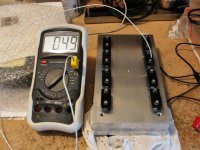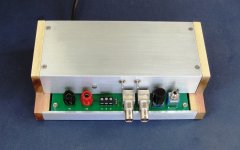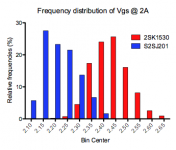So not one MOSFET yet properly measured, if that is the answer you are looking for.
Patrick
With all due respect this is not true!
Every single of the 1000+ MOSFETs have been properly curve traced up to 2.5A and I will publish the data here the coming days to involve the group in the process and the results obtained so far.
The MOSFETs have not yet been measured at 60˚C and I guess this must be what Patrick think is improper about my measurements, or the fact that I have not been using a XEN audio designed instrument
Stay tuned.
Nic
My mosfets matched on the curve tracer are sharing very well. The N channel are within 1mV of each other across Rs, and the P channel are within 10mV. Funny thing is, that it is consistent across both channels. In other words, both N sets match basically perfectly, and both P channel parts are off only slightly, but the same if comparing two channels.
Hi Nic,With all due respect this is not true!
Every single of the 1000+ MOSFETs have been properly curve traced up to 2.5A and I will publish the data here the coming days to involve the group in the process and the results obtained so far.
The MOSFETs have not yet been measured at 60˚C and I guess this must be what Patrick think is improper about my measurements, or the fact that I have not been using a XEN audio designed instrument
Stay tuned.
Nic
How do the N-P matching look with the preliminary curve tracing result?
Seriously, the more stringent matching can only reduce your "current yield", but by how much is going to be hard to predict.
Good work!!
The current yield of N-P match may change if "proper" testing shifts the measured Vgs of N and P devices differentially. It may actually both increase or decrease the yield. Fortunately we will not need to predict anything as the experiment will be doneSeriously, the more stringent matching can only reduce your "current yield", but by how much is going to be hard to predict.
Good work!!
As you will know from the number of devices available to the GB the yield of tight NNNN and PPPP quads is virtually complete.
Attachments
Alway good with a numerical definition of properly"properly measured" = measured under operating conditions
= 16V, 0~4A, 65°C Tc.
Under which operating conditions does the FETs run at 4A in the F5X

I thought the MOSFETs in the F5X was biased @ ~2A.
Cheers,
Nic.
yes the bias of the F5x is 2A.
That is also when the output is 0A.
1.) Increase the output to 1Apk and each of the FETs change their current from 2A to 2A+-0.5A, i.e. from 1.5A to 2.5A (the output = one FET minus the other FET)
2.) Increase the output current even further to 3.8Apk and each of the FETs change their current from 2A to 2A +-1.9A, i.e. from 0.1A to 3.9A.
3.) Increase the output current into ClassAB and the peak output current passes alternately from one FET or the other FET.
For case 2. the amplifier is using a current range in the FETs of essentially 0A to 4A while staying just on the limit of ClassA, where both devices are actively controlling the output current.
That is also when the output is 0A.
1.) Increase the output to 1Apk and each of the FETs change their current from 2A to 2A+-0.5A, i.e. from 1.5A to 2.5A (the output = one FET minus the other FET)
2.) Increase the output current even further to 3.8Apk and each of the FETs change their current from 2A to 2A +-1.9A, i.e. from 0.1A to 3.9A.
3.) Increase the output current into ClassAB and the peak output current passes alternately from one FET or the other FET.
For case 2. the amplifier is using a current range in the FETs of essentially 0A to 4A while staying just on the limit of ClassA, where both devices are actively controlling the output current.
from post130, The overlap of similar Vgs in the P&N sets is quite low in %age terms.
I can see that we are not getting a big yield in NNNNPPPP matching.
I see that NNNN & PPPP matching will give a much higher yield.
I further can tell from this tiny bit of data that NN, NN, PP, PP matching will have an even bigger yield than any of the preferred that so many of you have shown interest in.
I think you are going to have to be more realistic in your matching aspirations and further that price should be adjusted to make the NNNNPPPP matches more expensive than NNNN PPPP matches and that the NN, NN, PP, PP matches should be cheaper than either of the previous so that all the matched sets can be sold.
If prices are not adjusted in some way like this then everyone is going to stick with "give me the best matches".
I can see that we are not getting a big yield in NNNNPPPP matching.
I see that NNNN & PPPP matching will give a much higher yield.
I further can tell from this tiny bit of data that NN, NN, PP, PP matching will have an even bigger yield than any of the preferred that so many of you have shown interest in.
I think you are going to have to be more realistic in your matching aspirations and further that price should be adjusted to make the NNNNPPPP matches more expensive than NNNN PPPP matches and that the NN, NN, PP, PP matches should be cheaper than either of the previous so that all the matched sets can be sold.
If prices are not adjusted in some way like this then everyone is going to stick with "give me the best matches".
Andrew,
We knew from day 0 that there will be a small % of perfect NNNNPPPP matches.
So we have already been working on a solution to cover NNNN - PPPP matches, in the circuit.
The theory is done, and there will be an excel sheet to tell you how to adjust.
But we want to have experimental proof before publishing.
So I am also waiting for the test team to find time to test this.
FETs have already been sent from my own personal stock for that purpose.
Of course the NNNNPPPP will be more expensive than the NNNN - PPPP, proportionally to the % yield in the batch.
Anything else would not be fair.
How to allocate?
I have no idea. Nic makes the call in the end.
But I guess there is still plenty of time, till then.
BTW perfect explanation about the operating ranges.
I couldn't possibly have done better.

Patrick
We knew from day 0 that there will be a small % of perfect NNNNPPPP matches.
So we have already been working on a solution to cover NNNN - PPPP matches, in the circuit.
The theory is done, and there will be an excel sheet to tell you how to adjust.
But we want to have experimental proof before publishing.
So I am also waiting for the test team to find time to test this.
FETs have already been sent from my own personal stock for that purpose.
Of course the NNNNPPPP will be more expensive than the NNNN - PPPP, proportionally to the % yield in the batch.
Anything else would not be fair.
How to allocate?
I have no idea. Nic makes the call in the end.
But I guess there is still plenty of time, till then.
BTW perfect explanation about the operating ranges.
I couldn't possibly have done better.
Patrick
Theoretically yes.
But please don't make things more complicated.
I already said there is a solution, to be proven experimentally.
Why not just take my word for now ?
And as already explained, there is a second cancellation mechanism in the X.
So there is no real measurable issue. Just how perfect you want to be perfect.
Patrick
But please don't make things more complicated.
I already said there is a solution, to be proven experimentally.
Why not just take my word for now ?
And as already explained, there is a second cancellation mechanism in the X.
So there is no real measurable issue. Just how perfect you want to be perfect.
Patrick
yes, we know that.........We knew from day 0 that there will be a small % of perfect NNNNPPPP matches.
The list still shows almost everyone asking for NNNNPPPP sets.
Are we going to ask what lesser preference they will settle for if NNNNPPPP are not available to everyone?
I have already shown my lesser preference as NN, NN, PP, PP because I know that smal differences between the two channels will not in any way affect the performance of an individual channel.
I also realise that small differences between NN & PP in a single channel will make only a (very) small, if any, difference in channel performance.
Should someone on the team explain the implications for the different matching options that will be offered?
Should the potential buyers then, having been informed, be asked for their next or lesser preference?
My estimate is that there will be NNNNPPPP matched sets for all the Batch 1 F5X subscribers that will be interested, but not many more.
I estimate that the majority of the remaining FETs can be matched up in PPPP-NNNN sets with a defined offset of 120 mA. I might change idea, but my plan is to price NNNNPPPP and NNNN-PPPP sets roughly the same.
I will post my matching procedure and detailed results here this weekend.
Patrick consider my measurements "improper" and do not wish to comment on them, but some people might think differently, especially considering the enormous complication matching "properly" will be.
Will be back soon!
Nic
I estimate that the majority of the remaining FETs can be matched up in PPPP-NNNN sets with a defined offset of 120 mA. I might change idea, but my plan is to price NNNNPPPP and NNNN-PPPP sets roughly the same.
I will post my matching procedure and detailed results here this weekend.
Patrick consider my measurements "improper" and do not wish to comment on them, but some people might think differently, especially considering the enormous complication matching "properly" will be.
Will be back soon!
Nic
The devices
About a month ago I received a nice package from Davide containing 440 of 2SK1530 and 500 of 2SJ201 MOSFETs directly imported from reliable Japan vendors. These devices joined my private stock of 110 pairs of 2SK1530/2SJ201 devices (obtained from Zhou) and 4 pairs of NP-matched devices (also from Zhou), the property of Davide. I tried several ways to get another 60 of 2SK1530 devices at a reasonable price, but the samples I received were all fakes or used.
The pool for matching thus consists of 554 pcs of 2SK1530 and 614 pcs of 2SJ201.
I will donate the surplus 60 of 2SJ201 to Patrick/XEN audio as thank for his/their kind help.
About a month ago I received a nice package from Davide containing 440 of 2SK1530 and 500 of 2SJ201 MOSFETs directly imported from reliable Japan vendors. These devices joined my private stock of 110 pairs of 2SK1530/2SJ201 devices (obtained from Zhou) and 4 pairs of NP-matched devices (also from Zhou), the property of Davide. I tried several ways to get another 60 of 2SK1530 devices at a reasonable price, but the samples I received were all fakes or used.
The pool for matching thus consists of 554 pcs of 2SK1530 and 614 pcs of 2SJ201.
I will donate the surplus 60 of 2SJ201 to Patrick/XEN audio as thank for his/their kind help.
- Status
- This old topic is closed. If you want to reopen this topic, contact a moderator using the "Report Post" button.
- Home
- Group Buys
- GB NP matched Toshiba 2SK1530/2SK201 for F5X


